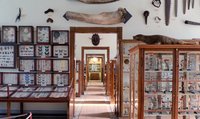Bei dieser Fotografie handelt es sich um eine Aufnahme aus dem Grab des Amunherchepeschef. Er war ein Sohn Ramses III. (1184-1153 v. Chr.), ein Pharao der 20. Dynastie (1186-1069 v. Chr.). Dieses, für das Neue Reich typische Felsgrab befindet sich im Tal der Königinnen in Theben-West.
Das Foto zeigt eine Wand der Vorkammer. Darauf finden sich Szenen des Königs Ramses III. vor verschiedenen Göttern.
Die Fotografie ist intakt. Auf der Rückseite steht mit Bleistift geschrieben:
"498
Tomb of Ammonkopehfu"
Das Foto muss zwischen 1904 und 1916 entstanden sein, da das Grab erst 1904 vom italienischen Ägyptologen Ernesto Schiaparelli entdeckt wurde.
Es ist intakt. Die Vorder- und Rückseite sind altersgemäß in einem guten Zustand.
en

